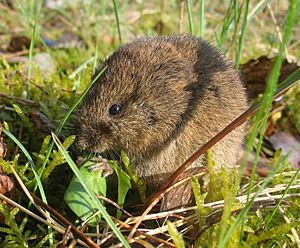Bank vole facts for kids
Quick facts for kids Bank Vole |
|
|---|---|
 |
|
| The Bank vole. | |
| Scientific classification | |
| Kingdom: | |
| Phylum: | |
| Class: | |
| Order: | |
| Family: | |
| Subfamily: |
Arvicolinae
|
| Genus: |
Myodes
|
| Species: |
M. glareolus
|
The bank vole (Myodes glareolus) is a small rodent. It has reddish-brown fur, sometimes with grey spots. Its body is about 100 millimeters (4 inches) long. Its tail is about 50 millimeters (2 inches) long. Bank voles usually weigh between 20 and 35 grams. They have a blunt nose and small eyes and ears.
Contents
Where Bank Voles Live
Bank voles live in many different places. You can find them in woodlands and oak forests. They also live on farms, in hedgerows, and in grasslands. They are found across most of Europe, but not in the far north or south. You can also find them in central, east, and north Asia.
How Bank Voles Behave
Bank voles are active both during the day and at night. They take many rests to avoid getting too tired. They build their nests in safe spots. These spots can be under logs, inside tree holes, or sometimes even underground. When autumn arrives, they gather and store food. This food helps them get through the winter months.
What Bank Voles Eat
Bank voles are omnivores. This means they eat both plants and other small creatures. Their diet includes insects and snails. They also enjoy grass, seeds, fungi, leaves, and fruit. Some of their favorite fruits are raspberry and hazelnut. Sometimes, they even eat the bodies of dead animals.
Life Cycle of the Bank Vole
Baby bank voles are born in cozy nests. These nests are made from grass, moss, and feathers. They are usually built above ground, often in trees. When the babies are born, they have no fur and cannot see. They drink their mother's milk for the first few weeks. A mother bank vole usually has about six babies at a time. She can have up to five groups of babies in one season. A baby born in spring will be old enough to have its own babies by fall. A bank vole typically lives for about 18 to 20 months.
Who Hunts Bank Voles
Bank voles have several natural enemies. Some of their main predators are Barn owls and Tawny owls. Other animals that hunt bank voles include the fox, the weasel, and the stoat.
Images for kids
-
Twigs of elder (Sambucus nigra) damaged by the bank vole
See also
 In Spanish: Myodes glareolus para niños
In Spanish: Myodes glareolus para niños




